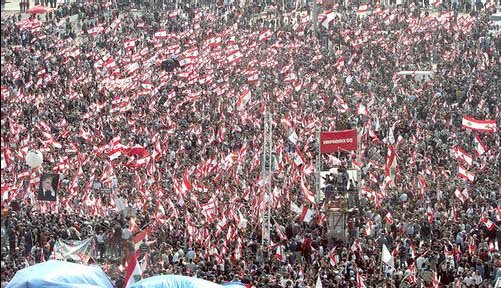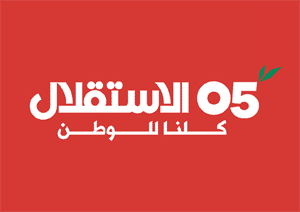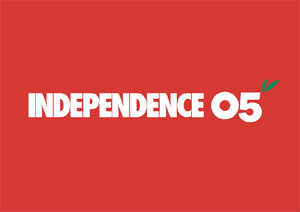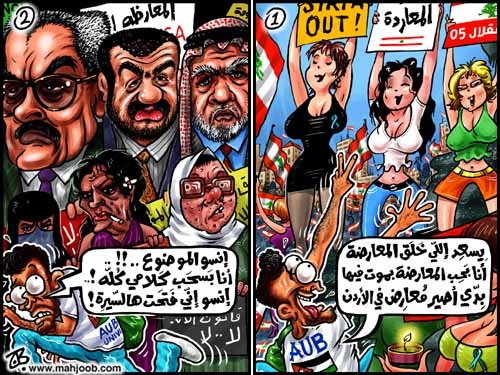
Remarkable images have been coming out of Beirut of the past few weeks. Yesterday the Lebanese opposition parties managed to get another huge turnout. Today, the Hizbollah led pro-Syrian rally was even bigger (between “a few hundred thousand” to a million people were on the street, depending on who you want to be believe).
We are probably witnessing a birth of a new era in this part of the world. “Democracy Stirs in the Middle East” declares this week’s cover of the Economist. The photo on the cover really says it all: It’s the image of the Cedar Revolution.
Leaving the politics of it all aside, there is an interesting media image phenomenon going on here. It’s the ‘branding’ of a revolution. And it’s not all accidental.

Let’s consider the branding elements at play here:
Brand name: The Cedar Revolution. That’s one strong brand name. It references the national symbol of Lebanon, the cedar tree.
Logo: The Lebanese flag. It’s the overwhelming symbol used in the demonstrations. Notable is the absence of the flags of the different opposition parties participating. There is definitely a clear decision to unify efforts, for now, under the national symbol of Lebanon.
Corporate design: Have you noticed the professionally designed ‘Independence 05’ posters. Designed in Arabic and English, these are visible in many of the photos of the demonstrations. Very powerful design: white, bold type on a solid red background and two green leafs. The ‘05’ logo also appears on an assortment of posters that have obviously been designed by some professional designer. The Lebanese are good at this!


This reminds me of the Solidarnosc logo used in Poland mid 80s revolution against the communists. The small demonstrations in Egypt are also branding themselves with word ‘Kefaya’ (English: Enough) written in spiky lettering inside a yellow circle.
Bilingual communication: the demonstrators are acutely aware that they are playing to both local and international audiences. The bilingualism of the banners is another aspect of branding and communication being employed by the Cedar Revolution.
Photographic language: Masses of people, peacefully demonstrating. Seas of Lebanese flags. FEMALES!! This last image aspect is extremely important. It is the single most powerful image coming out of Beirut. Young, energetic, emancipated women with Lebanese flags. This image has been reproduced hundreds of times over the past few days. The iconic picture used on the cover of The Economist is an example of that.

The image of cool girls demonstrating has not been lost on Jordan’s most famous cartoonist Emad Hajjaj, who produced some interesting work over the past few days. Emad Hajjaj is trying hard to find some middle ground between the Lebanese opposition and Syria. His position reflects the dilemma of many Arab artists and intellectuals. There’s something very appealing about people power toppling an Arab government. Then again.. Bush is supporting this particular revolution so maybe we should be against it and stand by Syria. So you see Emad Hajjaj’s position is not easy. His solution: make fun of the whole thing. His character Mahjoob plays the role of a Jordanian student at the AUB who’s salivating at the sight of the sexy Lebanese girls of the opposition. He just LOVES this opposition and wants to become a member of the Jordanian opposition. Next frame: the poor guy is totally turned off by the grim, ugly people in the Jordanian opposition. He runs away in disgust. Hajjaj’s depiction of the Jordanian opposition is right on! Apart from the typical Islamists and Arab Nationalists characters there’s also the cigarette-drenched-communist-feminist type! Truly hilarious.
In any case: The Lebanese have done it again. Proving that they are at the forefront when it comes to design and communication in the Arab world.
Comments
9 responses to “Branding the Cedar Revolution”
Ok, here is another brand name for you “The Gucci Revolution” Here is the BBC story
http://news.bbc.co.uk/1/hi/world/middle_east/4315223.stm
It is interesting that you see this as a tightly run PR campaign. If it is, I have to wonder who the organizers are targeting as their audience. The professionally designed signs, and I must admit, I like them too, and the images of westernized youth, men and women, are more sympathetic and effective to western eyes. However, the very same images mean something different to the locals, and perhaps they convey the exact opposite of what western audiences find appealing in them. There has been a long history in Lebanon of elite vs ordinary people, rich vs poor and westernized vs traditional. There is tremendous tension between those forces. Outside of Beirut, the country looks very different. Most of the post-war development that occurred in Beirut and allowed it to prosper and mature escaped the rest of the country. People from the south and east look at Beirut as being different and not part of their reality. Look at the HuzbAllah demonstration. By the most conservative estimate, it dwarfed the biggest opposition demonstration. And if you look at some of the signs, you will see the divide reflected in them (http://www.elaph.com/elaphweb/Resources/images/Politics/2005/3/thumbnails/T_013ab842-7090-4faf-930f-60163f528147.gif). So it seems to me that despite the success of the opposition to score points internationally, they still failed at reaching the local audience. Only time will tell whether that was a mistake or a well-calculated targeting of the only segment of the audience that matters.
Fantastic. Beirut is the mecca of Middle Eastern design, and as such, their revolution has been handsomely designed.
Our “Jordan: Small Country Big Ideas” campaign was fantastic. Designed by Saachi and Saachi (Ahmad? I could be wrong), too bad there wasn’t much substance behine the campaign. I felt the design for the Jordan 1st campaign was good, but not as good as the aforementioned Small Country one.
I truly believe our salvation lies partly in the arts, the literature and the design of urban spaces. Depressed people commit depressing acts, if you manage to alleviate the sense of helplessness and replace it with hope through a better economy and well designed cities and public spaces / structures, we might get somewhere.
As always, thanks for the great writing Ahmad.
Thanks everyone for you thoughtful comments. The size of the opposition’s demonstations should not be underestimated. Although it was reported that the pro-Syria demonstation ‘dwarfed’ the opposition’s demos, one has to remember the organizational and logistical capabilites of Hizbollah, and, undoubtedly, the following that they have.
Just to clarify.. I don’t think the whole opposition thing is a carefully run PR comapaign. A lot of it seems to be a spntaneous reaction to the assasination of Hariri. Part of the ‘branding’ that I am talking about is the result of spntaneous actions. The media also plays a role through the process of selection of images.
Anyway, today I saw yet another lebanese lady sitting on the shoulders of somone waving the flag. Only this time it was from the pro-Syria demo.
For me, the best thing about the demonstartion of the Lebanese opposition was that it crossed sectarian lines. I was in Beirut in September 2003. Some of the sectarian posters on the streets were just too much for me. Then I read Robert fisk’s “Pity the Nation”. A truly depressing book by the way.
To see people from different factions walking together was refreshing. Is this something that last.. Time will tell.
Great analysis Ahmad.
I know this is rather late-in-the-day, so just a quick comment:
Although I would not go as far as saying that this is a case study of good branding, it did come across as a coherent message from ‘the Lebanese’ in the early days of demonstrations. I say it was not a tightly run PR campaign, but I also add that it was certainly not spontaneous (unconscious). Any one that works in the media knows that there is such a thing as a totally spontaneous media campaign, nor there is a preplanned campaign that simply unfolds. Every campaign has a certain degree of uncertainty and contingency; a successfully run campaign is one which deals with contingency well. It is about successfully dealing with an uncertain situation at a particular moment. In that respect, one can also say that the ‘pro-Syrians’ were just as successful in subverting the ‘anti-Syrian’ campaign. For me (and I’m sure Ahmad would tend to agree), this is where creativity plays a role in the media, in dealing with contingency, not coming up with beautiful designs and images.
There are two other things worth looking at: the role of the media and how different media hijack, subvert and transform the original message, and the image of ‘the Lebanese’ as unified through the demos. However, there is little time and space for that here.. very interesting though!
Ahmad,
I’m Lebanese and appreciate the fact that you’ve chosen to highlight what’s happening in my country. But I have to tell you that this is not an organised PR campaign-people are just sick of Syrian terrorism in Lebanon. The fact that the opposition is made up of a lot of young people I think attributes to the fact that they are using snappy logos and posters. Yes, the fact that there are banners in English and French
Ahmad,
I’m Lebanese and appreciate the fact that you’ve chosen to highlight what’s happening in my country. But I have to tell you that this is not an organised PR campaign-people are just sick of Syrian terrorism in Lebanon. The opposition is made up of a lot of young people and I think this attributes to the fact that they are using snappy logos and posters. And yes, the banners in English and French are aimed at the international community. But the Lebanese have had enough of Syria and believe the international community can help. Let’s hope the situation doesn’t get out of hand.
Constitutional reforms… First
In a massive show of force yesterday, Al Wefaq held a huge rally in Sitra demanding constitutional reform, despite orders from the Interior Ministry to cancel it.